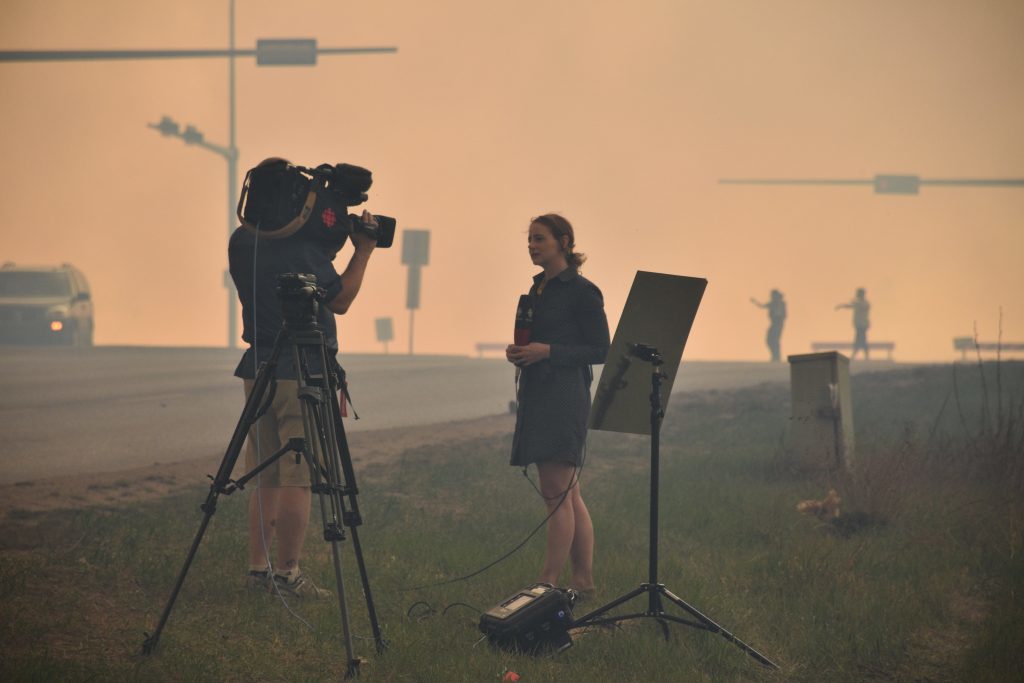Canadian journalists on their experiences covering natural disasters
Voices
CBC’s Briar Stewart on Covering the Wildfire in Fort McMurray
CBC News’s Briar Stewart discusses what it’s like to report a few feet away from a wildfire
In 2016, CBC News’s Briar Stewart left Edmonton with her crew at 8:30 a.m. to cover the wildfires in Fort McMurray, Alberta. By the time she arrived at 1 p.m., the fires had escalated significantly. Stewart and her crew had to move about five or six times. On the first night, they slept in their van in the parking lot of the fire station on the edge of Fort McMurray. Stewart’s stay culminated in a month-long reporting trip.

Smoke and wind made it difficult for CBC’s Briar Stewart to speak when she was reporting on the wildfire in Fort McMurray, Alberta, in 2016. (Courtesy Terry Reith/CBC)
Stewart: What sticks out for me the most is the live hit I did for CBC News Network on the first afternoon, because things had changed so much within the five to six minutes I was on camera. The smoke was very thick, and because it was windy, the fires create their own wind systems. It made it hard to speak for part of it because you’re just breathing in all this stuff. The ash and embers started to fall down from the tree, so I would be wiping my eyes as I was speaking on camera. There were a few different times where I had my hand up on my forehead to block all the debris that was being blown toward us.
When you’re reporting like that, you have your back to whatever is going on. I was pretty cognizant to always be looking around to see what was happening, so I could describe it to the host, Rosemary Barton. In this case, I was working with a cameraperson and producer, and you put a lot of trust in them to keep tabs on what’s going on. It was my cameraman that noticed that the grass across the street was on fire, and said at the end of the hit, “We’ve got to go. We’ve got to get out of here.” I was fortunate because I was in a team of three. Certainly, if I was out there by myself, I would not have been able to do the type of reporting that I did because more of my energy would have had to been focused just on the logistics. They took care of that and I could focus on the reporting and the story.
I was out there for a month. It didn’t drain me emotionally, but the people I met, the stories, and images stayed with me. I would think about it. Sometimes, I would have dreams where things would be burning, and I would think, “Oh, I wonder if I’m dreaming about fires because I spent so much of the last year covering them.” I ended up going back a few times that summer and following up with people. For some people, things were going relatively well with their insurance and everything was all getting into place rather quickly. For other people, things were really slow and they were really struggling financially and emotionally.
This interview has been edited for length and clarity.
CBC’s David Common on Covering the 2010 Haiti Earthquake
CBC’s David Common talks about what it was like covering the immediate aftermath of the 2010 Haiti earthquake
The New York Times’s Catherine Porter on Covering the 2010 Haiti earthquake
The New York Times‘s Catherine Porter discusses how covering the 2010 Haiti earthquake for Toronto Star influenced her
CBC’s Johanna Wagstaffe on Covering Hurricane Irma in Florida
CBC News’s Johanna Wagstaffe discusses the excitement and fear of reporting on the 2017 disaster
Photo courtesy: CBC
CBC’s Susan Ormiston on Covering Hurricane Irma in Florida
CBC’s Susan Ormiston discusses what it’s like reporting outside in a hurricane

